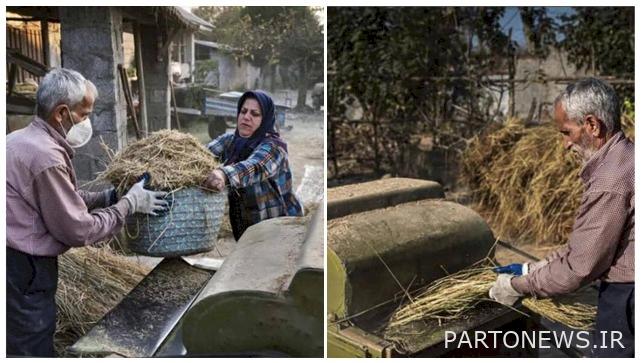Gilan harvest celebration, manifestation of culture of cooperation and empathy

Gilan Harvest Thanksgiving Ritual Ceremony is held every year on a seasonal basis after the end of the last crop, which includes rice and wheat. The naming ceremony of this ceremony called “Harvest Festival” is due to the time of its holding at the end of the crop year, and it is held to thank the Almighty God for a blessed crop year. In the past, this ceremony was held in most areas and cities of Gilan province and in the plains it was dedicated to the end of the rice harvest season and in the highlands to the end of the wheat harvest season, with the difference that the harvest Thanksgiving ceremony was also held in the plains villages.
After harvesting and harvesting, the owner of the harvest prepares a party and food by sacrificing goats or sheep, and invites his field helpers to lunch. These people went to the party of the party owner with their cattle and brought the crop to the village and stored it in a special warehouse. In the eastern regions of Gilan, these special warehouses are called Kunduj harvest and in the western regions of Gilan, they are called Krouj. In this celebration, singing with Gilaki songs for the harvest season was performed on the harvest and the road. The group had lunch in groups at the landlord’s house, and a celebration was held in the evening. On this day, people spontaneously and eagerly gathered on the land of the landlord or the last person who reaped their crop, and held happy programs such as Lafandbazi, Gilemardi ship, Qishbazi, horseback riding, and the special ceremony of that day, the “harvest ritual”. The special ceremony of this day includes a ritual display of the stages of planting, holding, harvesting and harvesting the harvested crop, which is accompanied by thanksgiving, joy and dancing.
This festival from the Sassanid period in the provinces of Gilan, Mazandaran, Kurdistan, Fars and Khuzestan (Izeh and Behban) was held every year on October 7, and this day was known as the harvest day, which with the arrival of Islam in Iran in the middle and late summer It took on a religious color and smell and during the end of the wheat harvest season, “Alam-Vachini” ceremonies were held in mountainous areas in the summer, the most famous of which is Alam-Vachini celebration in Shahshahidan Tomb, Sartarb Tomb and Tiolai village of Gilan.
Due to the role of water in the cultivation of its crop, this ceremony was usually held in agricultural lands in the plains, such as the village of Jamazu in Kurdistan and Izeh and Behbahan in Khuzestan.
Empathy and social communication have been other advantages of this type of ritual in the culture of the people of Gilan region. The opportunity to plant rice and the need for collective cooperation as well as the proximity of houses and fields in the villages have been the main reasons for the cooperation and participation of the people of Gilan villages in agricultural affairs. In this very beautiful tradition, which is the manifestation of cooperation and companionship in doing good deeds, the people help each other during planting, weeding and reaping, and this presence causes empathy, understanding, communication between the people, as well as resolving possible differences. In addition, the melody of rural and folk songs during the agricultural work and its recitation, the love and inner purity of individuals as a group work and also in the group that was hosted by the landlord with lunch in Fasanjan “in the local language of the black Qateq” Lays.
The celebration of Thanksgiving is the distribution of love and friendship among the people who reaped the land in goodness and blessings, and with thanksgiving to the threshold of oneness, the eyes are waiting for the spring Nowruz and the arrival of matters specific to the cold season.
Another prominent advantage of holding the “Gilan Harvest Festival” in previous periods is to help farmers whose crops have been damaged due to pests, floods, droughts or wildlife infestations. In other ceremonies, farmers allocated a portion of their crops to the injured person, reducing the losses caused by these accidents to the best of their ability, and removing the shadow of concern from the families of these people.
With the advent of urbanization and the development of agricultural machinery, the issue of aid and cooperation in rural areas has diminished, and at the same time the tendency of young people to migrate to cities has reduced the prosperity of agriculture in rural areas. Also, the various occupations of life along with the above-mentioned cases have caused the role of the harvest festival to diminish in the current situation.
In the 60’s and during the eight years of the imposed war, the focus of the people of the region to protect and defend national and religious values against the invasion of enemies, caused the forgetting of the harvest festival in the rice and wheat harvest season in Gilan. After two decades and conducting the author’s research, it was reopened and held in 2006 by “Nasir Mahalla Shaft Research and Conservation Base” on behalf of the General Directorate of Cultural Heritage, Tourism and Handicrafts of Gilan Province. Also, the registration file of this valuable cultural and local ceremony was registered in the list of national monuments of the country in 1391 with the serial number 1010.
This ceremony was held for 14 consecutive periods in Gilan province until 2009 before the outbreak of coronavirus. After the outbreak of this virus, due to the observance of health procedures to deal with this disease, the celebration of this celebration has been interrupted for two years.
.

